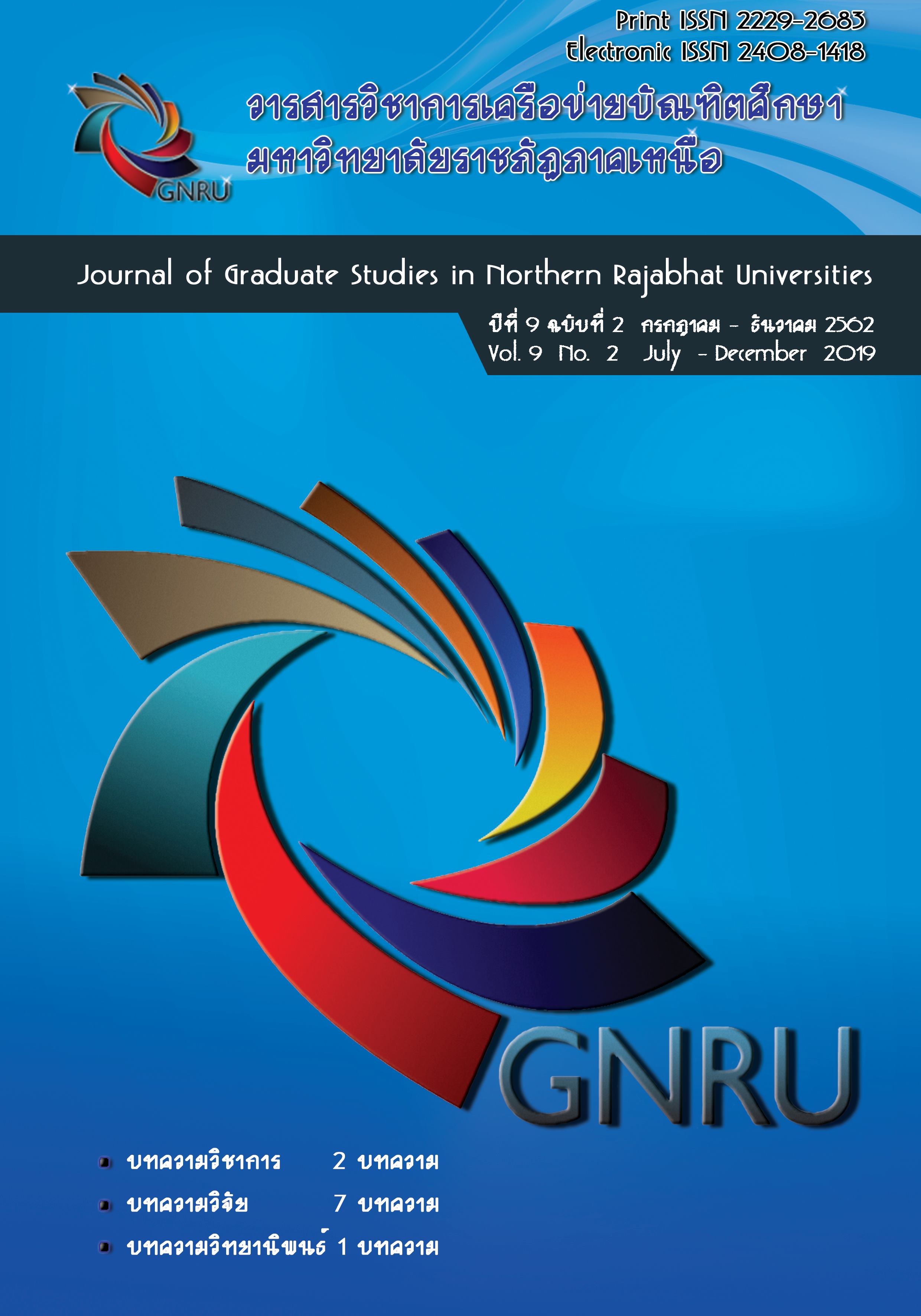กลวิธีการสอนอย่างมีประสิทธิภาพเพื่อส่งเสริมการฟัง พูดภาษาอังกฤษ ของผู้เรียนภาษาอังกฤษเป็นภาษาต่างประเทศ ในศตวรรษที่ 21 Effective Teaching Strategies to Promote Listening and Speaking English for EFL Learners in 21st Century
Main Article Content
Abstract
บทความนี้ กล่าวถึงการสอนโดยนำกลวิธีการเรียนรู้ที่มีประสิทธิภาพมาใช้ร่วมกับเทคโนโลยีเพื่อส่งเสริมทักษะการฟัง พูดภาษาอังกฤษของผู้เรียนภาษาอังกฤษเป็นภาษาต่างประเทศ ในศตวรรษที่ 21 กลวิธีการเรียนรู้ภาษา แบ่งเป็น กลวิธีทางตรงและกลวิธีทางอ้อม ซึ่งเป็นกลวิธีที่มุ่งเน้นบทบาทของผู้เรียนให้ได้ ฝึกทักษะการใช้ภาษาให้มากที่สุด ผู้สอนควรจัดกิจกรรมการเรียนรู้และบรรยากาศในห้องเรียนที่ส่งเสริมทักษะการฟัง พูดของผู้เรียน และใช้กลวิธีที่เหมาะสมกับความต้องการของผู้เรียน ได้แก่ กลวิธีการจำ (memory strategies) กลวิธีการเรียนรู้ทางปัญญา (cognitive strategies) กลวิธีการควบคุมอารมณ์ความรู้สึก (affective strategies) และกลวิธีทางสังคม (social strategies) กลวิธีเหล่านี้ช่วยให้ผู้เรียนประสบความสำเร็จในการเรียน รวมทั้งสามารถนำไปประยุกต์ใช้ด้วยตนเองร่วมกับเทคโนโลยีที่ทันสมัย เช่น แอปพลิเคชันในการเรียนภาษาสื่อออนไลน์ ซึ่งช่วยขับเคลื่อนให้ผู้เรียนเกิดความตื่นตัว (motivation) ในการเรียน
This article presents the teaching through effective learning strategies combined with technology to enhance English listening and speaking skills of foreign language learners in the 21st century. The language learning strategies are divided into direct and indirect strategies focusing on the role of the learners to practice language skills as much as possible. Teachers should organize learning activities and a classroom atmosphere that promotes learners’ listening and speaking skills and use appropriate strategies that are suitable for the need of the learners: memory strategies, cognitive strategies, affective strategies, and social strategies. These strategies help learners succeed in their learning as well as being able to apply by themselves with modern technology such as language learning applications, online media, which help learners become motivated in their learning.
Article Details
References
จิตตาภัทร์ บุญมี. (2558). การเปรียบเทียบทักษะการพูดภาษาอังกฤษและความมั่นใจในตนเองของนักเรียนชั้นมัธยมศึกษาปีที่ 4 ที่ใช้กลวิธีด้านปัญญาและกลวิธีทดแทน. ใน รายงานการประชุมวิชาการและนำเสนอผลงานวิจัย ระดับชาติและนานาชาติ ครั้งที่ 6 (87-97). มหาวิทยาลัยราชภัฏสวนสุนันทา. กรุงเทพฯ: ผู้แต่ง.
ทรงศรี สรณสถาพร. (2560). กลยุทธ์การเรียนรู้ภาษาอังกฤษของผู้เรียนชาวไทยในยุคประเทศไทย 4.0. วารสารวิชาการ มหาวิทยาลัยธนบุรี, 11(26), 9-23.
นุสรา มัตซูกิ. (2551). การศึกษากลวิธีการจำ กลวิธีปัญญา และกลวิธีทดแทน ในการเรียนภาษาไทยของผู้เรียนชาวต่างชาติ. สารนิพนธ์การศึกษามหาบัณฑิต (ภาษาศาสตร์การศึกษา). มหาวิทยาลัยศรีนครินทรวิโรฒ, กรุงเทพฯ.
ปวีณาการณ์ พลหาญ. (2562). การใช้กลวิธีการเรียนภาษาอังกฤษของผู้เรียนไทยที่เรียนทางด้านบรรณารักษศาสตร์กรณีศึกษานักศึกษามหาวิทยาลัยราชภัฏมหาสารคาม. วารสารสถาบันวิจัยและพัฒนา มหาวิทยาลัยราชภัฏมหาสารคาม, 6(1), 145-156. สืบค้นจาก https://www.tci-thaijo.org/index.php/rdirmu/article/view/211399/146464
กระทรวงศึกษาธิการ. (2542). พระราชบัญญัติการศึกษาแห่งชาติ พุทธศักราช 2542. กรุงเทพฯ: สยามสปอรต์ ซินดิเคท.
วิจารณ์ พานิช. (2555). วิถีสร้างการเรียนรู้เพื่อศิษย์ในศตวรรษ ที่ 21. กรุงเทพฯ: มูลนิธิสดศรี-สฤษดิ์วงศ์.
สิริ แหวนทอง. (2539, เมษายน–มิถุนายน). กฎการเรียนภาษาอังกฤษแบบเพื่อนคู่คิด-มิตรคู่ใจ. สารพัฒนาหลักสูตร, 15(125), 20.
Everyday Grammar: How to Ask for Clarification. (2019). Retrieved October 3, 2019 from https://learningenglish.voanews.com/a/how-to-ask-for-clarification/4726030.html
Chafe, W. (1986). Writing in the Perspective of Speaking. In C.R. Cooper & S. Greenbaum (Eds.). Written Communication Annual, Beverly-Hills, London: Sage Publications.
Chamot, A.U. (2001). The role of learning strategies in second language acquisition. In Breen, M.P. (Ed.). Learner contributions to language learning: New directions in research, 25-43. London: Longman.
Chang, C. Y., Liu, S. C., & Lee, Y. N. (2007). A study of language learning strategies used by college EFL learners in Taiwan. Language Learning, 3, 235-262. Retrieved from https://www.mdu.edu.tw/~ged/other% 20download/bulletin/20070319/11.pdf
Finnachiaro, M. (1964). English as a second language: from theory to practice. New York: Regent Publish Company.
Gilakjani, A., P. & Sabouri, N., B. (2016). Learners' Listening Comprehension Difficulties in English Language Learning: A Literature Review. English Language Teaching, 9(6), 123-133. Retrived October 1, 2019, from https://eric.ed.gov/?id=EJ1101226
Hall, J. and P. Saunders (1997). Adopting a student-centred approach to management of learning. In C. Bell, M. Bowden, and A. Trott (Eds.), Implementing Flexible Learning. London: Kogan Page.
Hwang, W., Huang, Y., Shadiev, R., Wu, S. & Chen, S. (2014). Effects of using mobile devices on English listening diversity and speaking for EFL elementary students. Australasian Journal of Educational Technology, 30, 503-516.
Retrived October 1, 2019, from https://www.researchgate.net/publication/267811279_
Effects_of_using_mobile_devices_on_English_listening_
diversity_and_speaking_for_EFL_elementary_students
Insiseingma, N., Sounthalavong, P., Sounthalavong, P., and Singthideth, O. (2018). An Investigation of English Listening Strategies Employed by Lao EFL College Students. The Golden Teak: Humanity and Social Science Journal (GTHJ.), 24, 1-11. Retrived October 1, 2019, from https://www.tci-thaijo.org/index.php/tgt/article/view/168416/121226
Jeanette, J., Gabriella, A.D., and Rani M. (2019, September). Students Affective Strategies and Anxiety in Learning English. Paper presented at 5th Internatioinal Scoholars' conference. From https://isc2017.apiu.edu/abstracts
Lessard-Clouston, M. (1997). Towards an Understanding of Culture in L2/FL Education. Ronko: K.G. Studies in English, 25, 131-150.
Levin, J. R. (1993). Mnemonic Strategies and Classroom Learning: A Twenty-Year Report Card. The Elementary School Journal, 94, 235–244. Retrieved from https://www.journals.uchicago.edu/doi/10.1086/461763
Lorayne, H. (1990). How to develop a super power memory. Toronto, Canada: Prentice Hall Canada.
McCormick, S. (1987). Remedial and Clinical Reading Instruction. Ohio: Merrill Publishing.
Megawati, F. & Mandarani, V. (2017, October). Ways for Tertiary Level Students In Building English Speaking Performance. Script Journal: Journal of Linguistic and English Teaching, 2(2), 136-144. Retrievd September 2, 2019, from https://jurnal.fkip-uwgm.ac.id/index.php/Script
Naiman, N., Frohlich, M., & Todesco, A. (1975). The Good Language Learner. TESL Talk, 6, 58-75.
Nguyen, Q. (2019). How to Chat with Robots to Learn English. Retrieved October 3, 2019, from https://www.fluentu.com/blog/english/chat-with-robot-to-learn-english
Oxford, R. (1990). Language Learning Strategies: What Every Teacher Should Know. Boston: Heinle &Heinle Publishers.
Oxford, R., L., & Reid. (1993). Research on second language learning strategies. Annual Review of Applied Linguistics, 13, 175-187.
Rima Aboudan. (2009). Laugh and Learn: Humor and Learning a Second Language. International Journal of Arts and Sciences. 3(3), 90-99.
Segura, A., R. (2012). The importance of teaching listening and speaking skills. Retrieved October 3, 2019, from https://www.ucm.es/data/cont/docs/119-2015-03-17-12.RocioSeguraAlonso2013.pdf
Shabani, M., B. (2015). On the relationship between foreign language anxiety and language learning strategies among Iranian EFL learners. Retrieved October 15, 2019, from https://www.ijeionline.com


